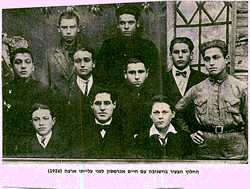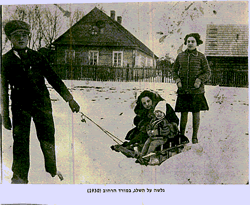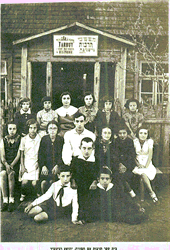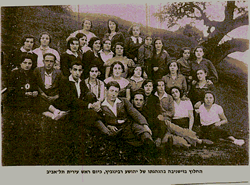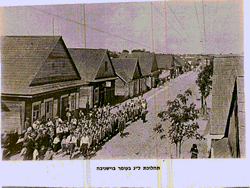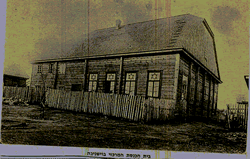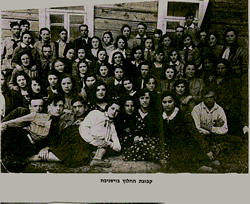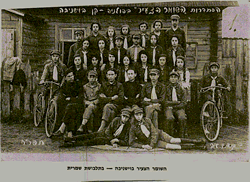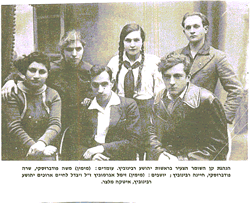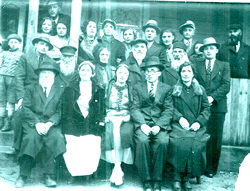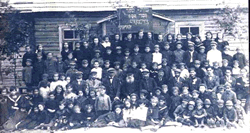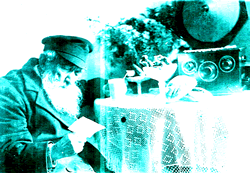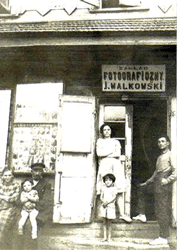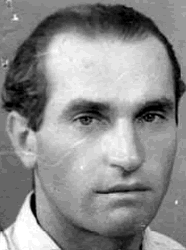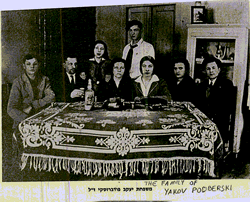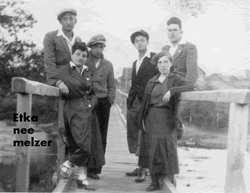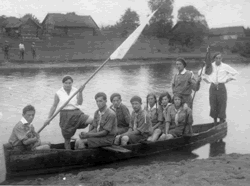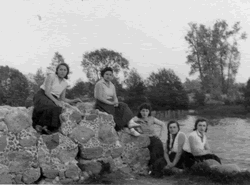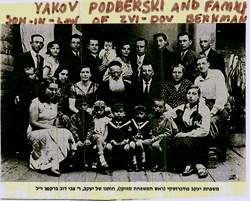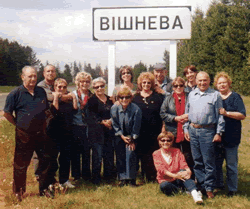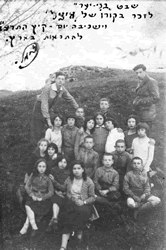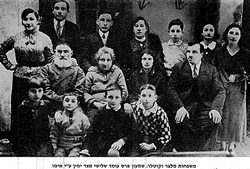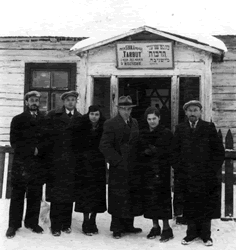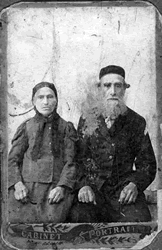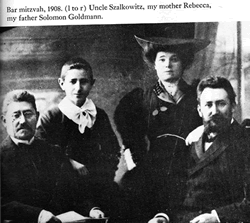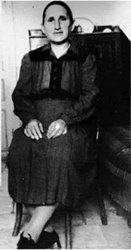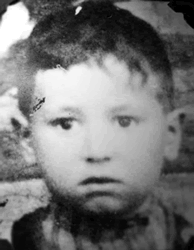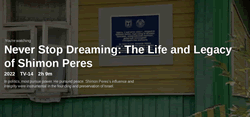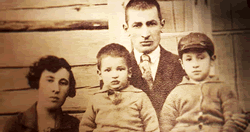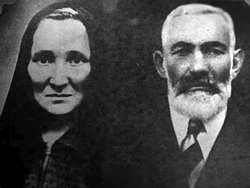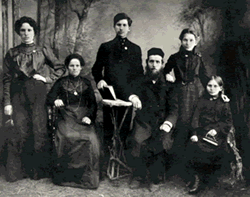|
#vf-1 Members of Hachaluth Hazair in Vishnevo (1926) Chaim Abramson is sitting in the middle ( picture taken days before his parting to Israel. |
#vf-2 Vishnevo, winter 1930 |
#vf-3 Students of the Vishnevo Tarbut school with their teacher: Yehoshua Rabinovich. Former finance minister (1974 - 1977) and mayor of Tel-Aviv (1969–1974) |
|
#vf-4 Hachalutz members in Vishnevo with leader Yehoshua Rabinovitz. |
#vf-5 Lag Baomer parade in Vishnevo. |
#vf-6 The main synagogue in Vishnevo |
|
#vf-7 Hachalutz members in Vishnevo. |
#vf-8 Vishnevo ; Members of Hashomer Hatzair Youth Movement 1928. |
#vf-9 Leaders of Hashomer Hatzair in Vishnevo: |
|
#vf-10:Do
you know these people?
|
#vf-11(detailed
slide show below)
|
#vf-12
|
#vf-13: Vilna Street, Vishnevo. The couple on the left; Beyla and Yizhak Zusman. Sitting on Yizhak' lap; Granddaughter; Sima Levin ( nee Volkovski) Standing under the Photography store sign; Simas' mother, Chana Volkovsky ( nee Zusman) On the left you see the pharmacy that was owned by Chjanas' brother; Feibe Zusman who perishedwith his entire family in Vishnevo. |
#vf-14: Gdaliahu Dodman |
#vf-15: The Podberesky/ Abramovitch family early 1930s'. Seating from left; |
| #vf-16: Vishnevo c late 1920s', Friends and Etka nee Melzer ( sister of |
#vf-17: Vishnevo c late 1920s', Hashomer Hatzair members. Yehoshua |
#vf-18: Vishnevo before the war. Please let us know if you recognize |
| #vf-19: Itcha Ber ( Zvi- Dov) Berkman with his son in law; Yaacov Podberesky |
#vf-20: The Melzers, Perski/ Peres families and other during a recent visit to Vishnevo |
#vf-21: Michael, son of Zvi Melzer |
#vf-22: Hashomer Hatzair group picture taken in Vishneva in 1932. It is before my father "Itzel" (Yitzchak) made Aliya to Eretz Israel. It was dedicated to my father by Zimel Abramovitz ( top left). Do you recognize anyone else in the picture? Please note that more pictures of Hashomer Hatzair youth movement, group Ha'Emek (ca. 1929) and group "Laor" (Ostrina, 1932) are posted on http://www.shtetlinks.jewishgen.org/lunna/eliashberg.html |
#vf-23: Zvi Hirsh and Rivka (nee Potashnik) Meltzer with some of their children and grandchildren |
#vf-24: Teachers standing in front of the "Tarbut" network's Hebrew day school in Vishnevo (Wiszniewo). 27727 Daniszewski - Danis Refael and Yaacov Hirsh Elishkevitz are amongst them |
#vf-25: Keila with husband; Dr. Binyamin, son of Aharon Dudman. Vishnevo c 1900 |
#vf-26: Nachum Goldman born in Vishnevo in 1894 at his bar Mitzvah in 1908 with his mother Rebecca nee Kwint or Baumgarten of Vilna. On the right is his father Solomon Goldman nee Liebman. On the left the brother of his father |
#vf-27: Nechama Dobe Miller (Zussman) Immediate Family: |
#vf-28: Shimon Peres (Persky) born in Vishnevo in 1923-- |
#vf-29: The hme of Shimon Peres in Vshnevo |
#vf-30: #pky-149: Shimon and Gershon Persky wth their parent s Yizhak Persky and Sara nee Meltzer |
| #vf-31: Zvi Meltzer and his wife ( the maternal grandparents of Shimon Peres) |
|
|
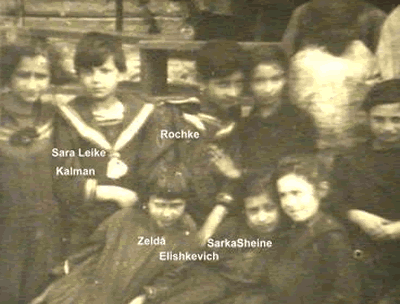 |
||
|
Detailed
Slide Show of #vf-11 (above)
|
||
Please share your comments or photos or links for posting on our Guestbook Page here: egl.comments@gmail.com
VISNEVO
(IN POLISH WISZNIEW, IN YIDDISH VISHNEVA)
A SMALL TOWN IN THE DISTRICT OF NOVOGRUDOK, BELORUSSIA, BETWEEN THE TWO WORLD
WARS PART OF POLAND.
VISNEVO WAS FOUNDED IN THE 14TH CENTURY , ON THE BANKS OF THE RIVER OLSHINKA.
THE BEGINNING OF JEWISH SETTLEMENT IN THE PLACE IS ATTRIBUTED BY TRADITION
TO THE JEWS OF BOGDANOW, A NEARBY VILLAGE, WHO ACCEPTED THE OFFER OF THE
OWNER OF THE LANDS, GRAF HERPATOVITZ, TO SETTLE IN THE PLACE AGAINST A
SMALL TAX. IN THE COURSE OF TIME, THEY WERE JOINED BY JEWS FROM
NEIGHBOURING SETTLEMENTS.
IN 1866 THE JEWS COMPRISED THE MAJORITY OF THE POPULATION, 500 OUT OF A
TOTAL OF 712. IN 1907 THEY NUMBERED 1863 OUT OF A TOTAL OF 2650. THE
SYNAGOGUE IS MENTIONED ALREADY IN 1892. THE INSTITUTIONS OF THE JEWISH
COMMUNITY WERE SET UP IN THE CENTRE OF THE TOWN, NEXT TO THE MARKET
PLACE. THE EDUCATION OF THE CHILDREN BEGAN WITH THE TRADITIONAL HEDER, AND
ALREADY BEFORE WORLD WAR I THE COMMUNITY HAD ALSO A HEDER METUKKAN
(REFORMED HEDER), IN WHICH HEBREW AND ARITHMETIC WERE ALSO TAUGHT. THE
OLDER CHILDREN CONTINUED THEIR STUDIES AT THE FAMOUS YESHIVOT OF THE TIME,
OUTSIDE VISNEVO. SOME OF THEM ACQUIRED ALSO GENERAL EDUCATION AND WHEN
THEY RETURNED HOME THEY BROUGHT WITH THEM THE INFLUENCE OF THE HASKALAH
(ENLIGHTENMENT) AND ZIONISM. A YESHIVA WAS ESTABLISHED AT VISNEVO IN 1910,
HEADED BY RABBI ISSER UNTERMAN, LATER (FROM 1964) ASHKENAZI CHIEF RABBI
OF ISRAEL. THE YESHIVA FUNCTIONED UNTIL THE OUTBREAK OF WORLD WAR I. WHEN
WORLD WAR I BROKE OUT (1914) THE JEWISH MEN WERE ALSO DRAFTED. IN AUGUST
1915 MOST OF THE TOWN'S HOUSES, WHICH WERE BUILT OF WOOD, INCLUDING THE
SYNAGOGUE, WENT UP IN FLAMES WITHIN TWO HOURS. RESTORATION WAS QUICK, BUT
THE WORK OF RECONSTRUCTION STOPPED WHEN THE FRONT LINE DREW NEAR. THE
INHABITNANTS DESERTED THE TOWN AND FLED TO THE WOODS. SOME OF THEM
RETURNED WITH THE GERMAN OCCUPATION OF THE PLACE AND OTHERS RETREATED
WITH THE RUSSIAN FORCES. WHEN THE FRONT AREA WAS STABILIZED , WITH
VISNEVO IN IT, ALL THE JEWS WERE EXPELLED FROM THE TOWN. THEY SCATTERED IN
NEIGHBOURING LITTLE TOWNS AND BECAME REFUGEES.
WHEN THE COMMUNIST REVOLUTION BROKE OUT IN 1917, THE RUSSIANS RETREATED
AND VISNEVO WAS OCCUPIED BY THE GERMANS. THE JEWISH REFUGEES RETURNED TO
THE TOWN AND FOUND IT COMPLETETY RUINED. THE FIRST SETTLED IN THE
SUBURBS, WHERE THE HOUSES WERE INTACT, AND THE OTHERS BEGAN THE WORK OF
RECONSTRUCTION. THE LOWER CLASSES OF A HEDER WERE OPENED IN A PRIVATE
HOUSE. AT THE END OF THE WAR (1918) , WHEN THE GERMAN ARMY WITHDREW , A
WAR BETWEEN THE SOVIET UNION AND POLAND STARTED, THE TOWN CHANGED HANDS
SEVERAL TIMES, UNTIL THE PEACE TREATY WAS SIGNED AND AN AGREED BORDER
WAS SETTLED IN 1922. VISNEVO WAS INCLUDED IN THE POLISH TERRITORY.
THE JEWISH COMMUNITY HAD TWO SYNAGOGUES, WHICH STOOD AT THE MARKET PLACE,
TWO HOUSES OF STUDY (BET MIDRASH) AND STUDY GROUPS ("SHAS" AND "EIN
YA'AKOV"). A THIRD SYNAGOGUE , "DIE KALTE SCHUL" (THE COLD SYNAGOGUE) WAS
CLOSED IN WINTER AND DURING THE REST OF THE YEAR WAS OPEN ONLY ON SABBATHS
AND FESTIVAL DAYS. AS IN THE TOWNS OF LITHUANIA, HASIDISM WAS NOT
PRreviewENT IN VISNEVO, YET A SMALL MINORITY BELONGED TO THE HASIDIM OF
SLONIM, AND THEY HAD THEIR OWN PRAYER HOUSE.
AMONG THE RABBIS OF VISNEVO IN THE 19TH CENTURY WAS EMINENT RABBI MEIR MARIM
SHAFIT, A GREAT SCHOLAR, WHO SERVED AS THE TOWN'S RABBI UNTIL 1849. RABBI
EPHRAIM PERLMAN-MARGALIT WAS THE TOWN'S RABBI FROM THE END OF THE 19TH
CENTURY UNTIL 1920, WHEN HE WENT TO ERETZ ISRAEL, WHERE HE SERVED AS RABBI
AT PETAH-TIKVAH AND LATER AT REHOVOT. HIS POST AT VISNEVO PASSED TO RABBI
ZUNDEL LURIE, WHO WAS THE TOWN'S RABBI UNTIL HIS DEATH IN 1924. HE WAS
FOLLOWED BY RABBI ZEVI EPHRON, A LIBERAL MINDED RABBI. HE WENT TO ERETZ
ISRAEL IN 1927 AND WAS APPOINTED AS RABBI AT REHOVOT. AFTER SOME TIME HE
RETURNED TO POLAND AND PERISHED IN THE HOLOCAUST. THE LAST RABBI OF
VISNEVO, RABBI ITZHAK WEINSTEIN, WAS APPOINTED TO THE POST IN THE SECOND
HALF OF THE 1930'S AND WENT TO ERETZ ISRAEL IN 1939.
THE SOURCES OF LIVING OF THE JEWS OF VISNEVO WERE VARIED. EVERY HOUSHOLD
HAD A SMALL PLOT FOR GROWING FOOD. POTATOES WERE THE MAIN CROP, HENCE THE
NICKNAME "POTATO-EATERS" BY WHICH THE JEWS OF VISNEVO WERE CALLED. THE
RELATIONMS BETWEEN THE JEWS AND THEIR NEIGHBOURS WERE BASED ON THEIR
MUTUAL ECONOMIC INTERDEPENDENCE. THE GENTILE FARMERS SOLD THEIR
AGRICULTURAL PRODUCE TO THE JEWS AND BOUGHT FROM THEM VARIOUS PRODUCTS.
THIS ECONOMIC ACTIVITY TOOK PLACE MOSTLY ON SUNDAYS, AFTER THE MORNING
PRAYERS AT THE CHURCHES, ON WEDNESDAYS, THE WEEKLY MARKET DAYS, AND IN A
NUMBER OF YEARLY FAIRS, WHICH ATTRACTED THOUSANDS, JEWS AND NON-JEWS ALIKE.
THE ECONOMIC DEVELOPMENT WHICH TOOK PLACE IN RUSSIA AT THE BEGINNING OF THE
20TH CENTURY AFFECTED ALSO VISNEVO. ROADS AND RAILWAYS WERE CONSTRUCTED,
THE CONNECTION WITH THE OUTSIDE WORLD EXPANDED, TRADE DEVELOPED. JEWISH
MERCHANTS BOUGHT THE LOCAL PRODUCE ((GRAIN, TIMBER) AND SOLD IT IN THE
NEIGHBOURHOOD AND IN THE TOWNS OF THE DISTRICT. SHOPS WERE OPENED, AS WELL
AS WORKSHOPS SUCH AS AN OIL-PRESS, TANNERY, AND A CARPENTRY FOR JOINING
VIENNESE FURNITURE. A MATCH FACTORY, WHICH A JEW FROM KOVNO FOUNDED,
EMPLOYED LOCAL WORKERS. IT WAS DESTROYED IN WORLD WAR I. ALONG WITH A SMALL
GROUP OF WEALTHY MERCHANTS, WITH INFLUENCE IN THE COMMUNITY, THERE WERE
ALSO CRAFTSMEN AND PEDDLERS WHO HAD DIFFICULTY IN MAKING A LIVING.
PRIOR TO WORLD WAR I, THE COURT OF THE LOCAL NOBLE WAS THE FOUNDATION OF THE
ECONOMIC ACTIVITY. JEWS LEASED FROM THE "COURT" FOREST PARCELS, THE BIG
DAIRY, TO WHICH THE MILK FROM ALL THE "COURT"'S COW-SHEDS WAS BROUGHT, AND
THE DISTILLERY OF SPIRITS. IN THE PERIOD AFTER THE WAR, FINANCIAL SUPPORT
FROM RELATIVES IN AMERICA BECAME AN IMPORTANT ELEMENT IN THE LIVING OF PART
OF THE TOWN'S JEWS.
WHEN THE POLISH RULE STABILIZED, THE ECONOMIC ACTIVITY WAS RENEWED. WITH
THE HELP OF A FUND CREATED BY THE "JOINT" TO ASSIST IN THE REHABILITATION OF
JEWISH SETTLEMENTS HURT BY THE WAR, A LOAN AND SAVING FUND WAS
ESTABLISHED. IT RENDERED HELP TO THE COMMUNITY IN RESTORING ITS
INSTITUTIONS, AND INDIVIDUALS WERE GRANTED LOANS FOR BUILDING HOUSES OR
SETTING UP A BUSINESS. SOME JEWS ACQUIRED LAND AND MADE A LIVING FROM
FARMING. JEWS DOMINATED THE TRADE IN WINES AND SPIRITS, DEALT IN
MANUFACTURING DAIRY PRODUCTS AND THE EXPORT OF HARD CHEESES, SUPPLIED
AGRICULTURAL MACHINERY TO THE POLISH NOBILITY AND THE RICH FARMERS. THANKS
TO THE JEWS, THE NON-JEWISH FARMERS LEARNED THE USE OF CHEMICAL FERTILIZERS.
DURING THE 1930'S MANY YOUNG CHRISTIANS FROM THE VILLAGES BEGAN MOVING
INTO THE TOWNS TO ACQUIRE TRADES, AND WHEN THEY RETURNED HOME THEY TOOK THE
PLACE OF JEWS AS SUPPLIERS TO THE FARMERS. THEY ALSO OPENED SHOPS WITH THE
ASSISTANCE OF THE AUTHORITIES. ON TOP OF ALL THAT CAME THE CRISIS OF THE
EARLY 1930'S, WHICH AFFECTED ALL BRANCHES OF THE ECONOMY. RELATIONS BETWEEN
THE JEWS AND THEIR NEIGHBOURS DETERIORATED. IN THE SECOND HALF OF THE
DECADE ANTISEMITIC PROPAGANDA INTENSIFIED.
THE ZIONIST MOVEMENT, WHICH MADE ITS FIRST STEPS IN THE COURSE OF WORLD WAR
I, MADE GOOD PROGRESS IN THE PERIOD BETWEEN THE TWO WARS. HALUTZIM
(PIONEERS) FROM RUSSIA, ON THEIR WAY TO ERETZ ISRAEL, BROUGHT WITH THEM
THE ZIONIST IDEA, AND A BRANCH OF "ZEIREI ZION" WAS FORMED AT THE TOWN. A
CIRCLE OF "MAX NORDAU" YOUTH WAS ESTABLISHED, AND WITH THE INFLUENCE OF
"ZEIREI ZION", IT DEVELOPED INTO THE YOUTH ORGANIZATION "HERUT VE-TEHIYA" IN
1921. A DRAMA GROUP WAS ALSO FOUNDED, WHOSE EARNINGS WENT TO SUPPORT
ZIONIST ORGANIZATIONS AND SETTING UP A LIBRARY. ALTOGETHER, A VARIED
ZIONIST ACTIVITY OF RAISING MONEY, DISSEMINATION OF INFORMATION, AND THE
SALE OF "SHEKELS" TOOK PLACE.
THE MEMBERS OF "HERUT VE-TEHIYA" WERE THE LIVELY ELEMENT IN EVERY ZIONIST
ACTIVITY, THEY WERE CLOSE TO "ZEIREI ZION", AND IN TIME WERE ABSORBED INTO
THEM AND INTO THE HE-HALUTZ ORGANISATION, WHICH WAS FORMED IN 1922. THE
YOUNGER ONES WERE ORGANISED IN HE-HALUTZ HA-ZAIR (YOUNG PIONEERS) AND JOINED
TRAINING KIBBUTZIM FOR ALIYAH TO ERETZ ISRAEL. THE FIRST GROUP FROM VISNEVO
WENT TO ERETZ ISRAEL IN 1925. IN 1928 BRANCHES OF THE YOUTH MOVEMENTS
"HASHOMER HAZAIR" AND "BETAR" WERE ESTABLISHED.
THE TARBUT SCHOOL, WHOSE FOUNDATIONS WERE LAID DURING WORLD WAR I, DEVELOPED
AFTER THE WAR IN A BUILDING WHICH THE COMMUNITY ERECTED FOR IT NEAR THE
SYNAGOGUE AT THE MARKET PLACE. AT THE END OF THE 1930'S IT WAS ATTENDED
BY 200 PUPILS IN EIGHT CLASSES. ON THE EVE OF WORLD WAR II A HEBREW
KINDERGARTEN WAS OPENED. AT THAT TIME ALL THE ZIONIST PARTIES WERE ACTIVE AT
VISNEVO. THE ANTI-ZIONIST "AGUDAT ISRAEL" WAS ALSO REPRESENTED. THE
ACTIVITY OF THE "BUND" , WHICH BEGAN ALREADY AT THE TIME OF THE 1905
REVOLUTION, AND WHICH STOOD AT THE BASE OF THE JEWISH SEL-DEFENCE, DECLINED,
AND A PART OF ITS ACTIVISTS EMIGRATED TO THE U.S.A. A BI-LINGUAL LIBRARY (IN
HEBREW AND IN YIDDISH) WHOSE FOUNDATIONS WERE LAID ALREADY IN WORLD WAR I,
WAS NAMED IN THE 1930'S "THE I.L. PERETZ VISNEVO LIBRARY". IT HELD 1300
VOLUMES IN HEBREW AND 1800 IN YIDDISH.
MANY OF THE JEWS OF VISNEVO EMIGRATED TO ERETZ ISRAEL DURING THE PERIOD
BETWEEN THE TWO WORLD WARS. SOME OF THEM TOOK PART IN THE MOVEMENT OF
SETTLEMENT ON THE LAND AND IN THE WAR OF INDEPENDENCE. AMONG THE ONCE
VISNEVO JEWS ARE WELL KNOWN NAHUM GOLDMANN, WHO WAS CHAIRMAN OF THE WORLD
JEWISH CONGRESS AND ONE OF THE INITIATORS OF THE CONCEPT OF THE MUSEUM OF
THE DIASPORA (BETH HATEFUTSOTH), WHICH IS NAMED AFTER HIM; YEHOSHUA
RABINOVICH, WHO WAS MAYOR OF TEL AVIV AND A MINISTER OF FINANCE IN THE
GOVERNMENT OF ISRAEL; SHIMON PERES, A FORMER PRIME MINISTER OF ISRAEL; AND
ABRAHAM DICKENSTEIN, ONE OF THE FOUNDERS OF BANK HAPOALIM.
ON THE EVE OF WOLRD WAR II ABOUT 700 JEWS WERE LIVING AT VISNEVO. WHEN THE
WAR BROKE OUT (SEPTEMBER 1939) MANY JEWISH FAMILIES FROM THE GERMAN
OCCUPATED PARTS OF POLAND CAME TO VISNEVO. THEY WERE ABSORBED BY THE
COMMUNITY AND THE NUMBER OF JEWS IN THE TOWN ROSE TO SOME 2000.
THE HOLOCAUST PERIOD
FOLLOWING THE AGREEMENT BETWEEN GERMANY AND THE U.S.S.R. (THE RIBBENTROP-
MOLOTOV PACT OF AUGUST 1938), AND THE OCCUPATION OF POLAND BY GERMANY IN
SEPTEMBER 1939, THE EASTERN PARTS OF POLAND, INCLUDING VISNEVO, CAME
UNDER THE RULE OF THE U.S.S.R. ALL ZIONIST ACTIVITY WAS SUPPRESSED, THE
COMMUNITY'S COUNCIL WAS ABOLISHED, THE HEBREW SCHOOL WAS CLOSED DOWN AND A
SCHOOL IN YIDDISH AND A SCHOOL IN RUSSIAN WERE OPENED IN ITS PLACE. ALL THE
HEBREW BOOKS WERE REMOVED FROM THE LIBRARY AND IT WAS MERGED INTO THE POLISH
LIBRARY. THREE JEWISH FAMILIES WHOSE HEADS WERE ACCUSED WITH
ANTI-COMMUNISM WERE EXPELLED TO THE USSR, BUT THANKS TO THAT THEY SURVIVED
THE WAR AND EVENTUALLY WENT TO ISRAEL.
ON THE 22ND OF JUNE 1941 THE GERMANS OPENED THEIR ATTACK ON THE USSR. MOST
OF THE JEWS WHO HAD ESCAPED FROM THE TOWN HAD TO TURN BACK , SOME OF THEM
WERE KILLED ON THE WAYS, A FEW SURVIVED. ON THE 17TH OF JUNE THE GERMANS
ENTERED THE TOWN. THEY CONCENTRATED THE JEWS OF VISNEVO, THE WOMEN AND
CHILDREN WERE ALLOWED TO RETURN TO THEIR HOMES, WHILE THE MEN WERE
APPARENTLY HELD AT THE SYNAGOGUE BUILDING AND WERE TAKEN FROM THERE TO
FORCED LABOUR.. THEIR FOOD WAS SUPPLIED BY THE FAMILIES. THE GERMANS
APPOINTED A LOCAL MILITIA, HEADED BY TWO INHABITANTS OF GERMAN EXTRACTION,
WHICH ILL-TREATED THE JEWS. ON ONE OCCASION, TWO JEWS WERE MURDERED, AND
PERMISSION TO GIVE THEM A JEWISH BURIAL WAS DENIED. ON ANOTHER OCCASION,
ON THE INITIAVIVE OF A GERMAN OFFICER, 38 MEN WERE TAKEN OUT OF THEIR
HOMES BY NIGHT, SHOT DEAD AND DROPPED INTO A PIT WHICH HAD BEEN PREPARED
FOR THAT PURPOSE. FROM TIME TO TIME THE COMMUNITY WAS DEMANDED TO PAY
RANSOM, AND WHEN THE DELEGATES OF THE COMMUNITY BROUGHT THE RANSOM, WHICH
INCLUDED GOLD ARTICLES, SILVER AND JEWELLERY, TO THE GERMAN COMMAND, THEY
WERE BEATEN BY THE LOCAL POLICE ON THE INSTRUCTION OF THE GERMANS.
WHEN THE JEWS WERE ORDERED TO MOVE INTO THE GHETTO THEY NUMBERED ABOUT 1000
PEOPLE. THE GHETTO WAS SURROUNDED BY BARBED WIRE AND GUARDED AT THE
ENTRANCE GATE. THE AREA OF THE GHETTO COMPRISED THE SYNAGOGUE COURTYARD AND
THE ADJOINING STREET. THE GERMANS APPOINTED A JUDENRAT (COUNCIL OF THE
JEWS) WHICH WAS RESPONSIBLE FOR CARRYING OUT THEIR ORDERS. THE JUDENRAT
WAS CONSTANTLY FACING DEMANDS FROM THE GERMANS AND THE LOCAL AUTHORITIES FOR
MORE AND MORE MONEY. SOMETIMES PEOPLE WERE ABDUCTED IN THE STREETS AND
WERE RELEASED ONLY AGAINST PAYMENT OF RANSOM. WHEN THE MEMBERS OF THE
JUDENRAT FAILED TO COMPLY IN TIME, THEY WERE BROUGHT TO THE MARKET SQUARE
AND THERE MALTREATED. POLISH YOUTH WHO OPERATED CLANDESTINELY IN THE WOODS
KEPT CONTACT WITH THE JUDENRAT, BUT THEIR PLANS FOR AN UPRISING DID NOT
MATERIALIZE.
ON THE NIGHT BEFORE THE 17TH OF THE MONTH OF ELUL 5702 (30 AUGUST 1942) THE
GHETTO WAS SURROUNDED BY SOLDIERS. AT DAWN, ALL THE JEWS IN THE GHETTO WERE
ORDERED TO ASSEMBLE AT THE COURTYARD OF THE SYNAGOGUE.. THE SICK, WHO WERE
UNABLE TO LEAVE THEIR BEDS, WERE SHOT ON THE SPOT. THE JEWS STILL BELIEVED
THAT THE OBJECT WAS MOVING THEM TO A LABOUR CAMP. GROUP AFTER GROUP THEY
WERE TAKEN TO THE END OF THE GHETTO STREET, FORCED TO KNEAL DOWN FACING A
WALL OF A DERELICT BUILDING, SHOT IN THEIR BACKS AND HURLED INTO THE
BUILDING, MANY OF THEM STILL ALIVE. WHEN THE SHOTS AND THE SCREAMS OF THE
FIRST GROUP OF VICTIMS WERE HEARD, THE PEOPLE THEN STILL ON THE TRUCKS
REALISED WHAT WAS AWAITING THEM AND JUMPED OFF THE TRUCKS IN THE HOPE OF
ESCAPING INTO THE FIELDS AND WOODS. ONLY A FEW MANAGED TO GET AWAY, ALL
THE OTHERS WERE SHOT BY THEIR PURSUERS, AND THEIR BODIES REMAINED STREWN
ALL OVER THE SPACE BETWEEN THE TOWN AND THE WOOD. AFTER THE MASSACRE, FIRE
WAS SET TO THE BUILDING.
THE MASACRE TOOK PLACE ON SUNDAY, AND THE INCESSANT RINGING OF THE CHURCHES
BELLS SUMMONED INTO THE TOWN THOUSANDS OF VILLAGERS. THEY CROWDED AROUND
THE BURNING BUILDING AND HEARD THE SCREAMS OF THE DYING. THE LAST OF THE
VICTIMS WAS THE TOWN'S DOCTOR, PODZELBER, WHO WAS WELL KNOWN IN THE AREA
AND EVEN THE GENTILES ASKED TO SPARE HIM, BUT TO NO AVAIL. AMONG THOSE WHO
MANAGED TO ESCAPE WERE THREE YOUNG BOYS. TWO OF THEM SURVIVED AMONG THE
PARTISANS , AND THE THIRD MANAGED TO STAY ALIVE BY ROAMING ABOUT AND HIDING
IN SEWERS. ELEVEN MORE OF THE JEWS OF VISNEVO REMAINED ALIVE BECAUSE THEY
HAPPENED TO BE AWAY AT LABOUR CAMPS OUTSIDE THE TOWN.
THE SURVIVORS ROAMED THE WOODS AND AS PARTISANS RETURNED TO THE TOWN AND SET
IT ON FIRE. THE HOUSES OF THE JEWS WERE OCCUPIED BY MANY GENTILES FROM THE
VICINITY WHO HAD TAKEN PART IN THE MASSACRE AND LOOTED THEIR PROPERTY. A
CARPENTER'S SHOP WAS SET UP IN THE BIG SYNAGOGUE. THE JEWISH PARTISANS
FROM VISNEVO JOINED A COMPANY OF RUSSIAN PARTISANS AND TWO OF THEM WERE
KILLED IN ACTION. AFTER THE WAR THE OTHERS WENT TO ISRAEL OR EMIGRATED TO
THE U.S.A.
WHEN THE TERRITORY OF BELORUSSIA WAS LIBERATED IN THE SUMMER OF 1944, 18
JEWS WERE AT VISNEVO. WHEN ONE OF THEM WAS MURDERED, THE OTHERS REALIZED
THAT THE TIME HAD COME TO LEAVE, AND THEY LEFT TO GO TO ERETZ ISRAEL.
THE PARTISANS WHO VISITED VISNEVO AFTER THE LIBERATION DUG A MASS GRAVE AND
ERECTED ON IT A TOMBSTONE. A MEMORIAL STONE WHICH THE SOVIETS ERECTED IN
MEMORY OF THE VICTIMS OF THE HOLOCAUST DOES NOT STATE THAT THEY WERE
JEWS.
IN THE SUMMER OF 1990 THE JEWISH CEMETERY WAS REVEALED ON THE OUTSKIRTS OF
THE TOWN. THE PLACE WAS OVERGROWN WITH TREES AND ONLY THE TOPS OF THE
GRAVESTONES WERE VISIBLE HERE AND THERE.
BETH HATEFUTSOTH - FAMILY NAMES AND COMMUNITIES DATABASE
Execution of Jews in Vishnevo
http://www.yahadmap.org/#village/vishnevo-wiszniew-vishneva-minsk-belarus.890
Podberesky family c. 1902
LEFT: Ethel Farberman Gordon – married to Max Podberesky "Gordon" . Center, standing: Philip Podberesky "Gordon" who left for America c.1910 and married Ethel Farberman's sister Katie. The two sisters were from Dolhinov. The brothers and sisters were also cousins. Right, standing: Dishke-Libby nee Podberesky who married Izadore Levine (also a cousin). She was shot in the leg during protests/strikes in NYC for ladies garment workers.
Seated: Ester Genya – 2nd wife of Zev Wolf Podberesky . His first wife, Basha-Ita Danischevsky (also known as "Alte" because she was the sole survivor of 11 children who died as infants) died at approximately age 33, shortly after my grandmother (far right) was born). Center seated: my great grandfather Zev Wolf Podberesky (he was born in Vishneveh). When all of the children except Rivka-Baila (my grandmother) had left for America, he and Rivka Baila and Ester Genya were (living in Ilya) caught in the ravages of WWI and the Russian Revolution and became stateless refugees. Esther Genya had a farm near Smargon and during the Russian Revolution or WW1 went to gather food there and was never heard from again. Zev Wolk and Rivka Baila were forced from their home in winter. During that time he died of pneumonia and she was left alone. She wandered for 4 more years before walking to to the free port of Danzig and coming to America. Far Right: my grandmother, Rivka-Baila (she married Joseph Schuster from Bozalia, Ukraine)
Note: They all dropped the name Podberesky and took the name "Gordon" upon coming to America. For more pictures and information go to; http://www.eilatgordinlevitan.com/volozhin/vol_pages/vollinksframe.html
and click:
Rare Antique Russian Imperial Samovars
Zane Buzby
Remarks by U.S. Ambassador George Krol at the Dedication of the
Holocaust Memorial in Vishneva
Respected Friends,
Thank you for this opportunity to say a few words. I speak not only as
the ambassador of the United States of America, a country that is now
home to some of the Jewish survivors of Vishneva. I speak also as a
human being at one with all of you and with those who died here. This
tragedy indeed knows no nationality but is a lesson and a warning to
all of humanity.
We are here today to commemorate the Jews of Vishneva who suffered and
perished here during the Holocaust. Their fate was not alone but was
repeated in virtually every town and village throughout Belarus,
ending the the centuries old existence of what was once a flourshing,
vibrant Jewish culture.
Vishneva as we know was once a center of learning and culture, the
birthplace of great scholars and statesmen such as Shimon Peres. That
culture is gone now from this place. The memories of those Jews who
miraculously escaped death here or were fortunate enough to have left
this place before the Holocaust are now fading as the eye witnesses of
this barbarism and tragedy pass from this world.
It is therefore right and fitting that today we strive to keep alive
the memory of this tragedy, the memory not only of those who died here
but also the memory of a great civilization that is no more.
It is not only appropriate but necessary to pass on the memory of what
happened here to the generations that follow lest such horror, such
hatred, such intolerance, such evil ever be repeated on this soil or
on the soil of any of our countries.
The men, women and children who perished here speak to all of us. Let
us listen, let us mourn, let us never forget.
Thank you for your attention.
Dear all,
I have just published, through Urim Publishers, a 270 page book
about Rabbi Boruch Milikowsky, son of Shmuel Milikowsky and Malke Dickenstein, who
was born and raised in Vishnevo. The Book is called, "They called him Rebbe: The
Life and Good Works of Rabbi Boruch Milikowsky."
The first sixty pages are about his life in Europe -- his childhood
in Vishnevo, his experiences in the yeshivot of Radin, Baranovitz and the
Mir, the arrival in Vishnevo of the Russians, the arrival of the Nazis, and
finally, his escape, with the Mir Yeshiva to Shanghai, China.
The remaining 200 pages are about his success as an educator of
American students over the course of a forty year career in the Talmudical
Academy of Baltimore, Maryland.
Some of my source material necessarily came from this and other
relevant Internet sites, but some of it came from long interviews with members
of Rabbi Milikowsky's family, including Mrs. Minna Podeberesky, wife of Noah and
sister of Rabbi Milikowsky.
The book is for sale already in the Pomerantz bookstore in
Jerusalem. In a few weeks it will be reaching the shores (and stores) of the United
States and other English speaking countries, wherever "Urim" books are sold.
Thank you,
Raphael Blumberg
Israel
rdb1000@actcom.net.il
15/07/2007
Shimon Peres' speech on the occasion of his inauguration as President
of Israel
I stand here today moved and appreciative of the trust you have placed
in me on behalf of our people. Your trust is of value to me, it places
a great duty on me, one which I, as President of the State, will carry
with reverence and a deep feeling of mission.
I shall be committed to nurture unceasingly those fine threads of
fabric, which weave us together as a nation, when among us there are
people with various opinions who fiercely fight for them. It must
always be remembered that we are the sons and daughters of one Land of
Israel. We do not have, and we are not looking for, another country.
You, here in the Knesset, will continue to maintain the existential
polemics, as this must be so in a democratic parliament, while I will
devote myself to the unifying, in order for it not be harmed in the
fervor of the storm.
In my heart, today, there dwell together joy, facing the challenge you
have placed on me, but also sadness at the hour of parting.
I am leaving this house - the beating heart of Israeli democracy,
after having saddled its benches for forty-eight years, more than half
of my life.
I loved its deafening volume, the great debates, the soul reaching
tumults and the unexpected reconciliations. I know that this house is
able to take historical decisions even when democracy is storming.
I know that I am now moving from the executive arm to the unifying
shoulder. I am no longer the messenger of a party but a trustee of the
nation, of all the citizens of the state. From this moment I will be
the voices and the address for every citizen of the State of Israel,
for every baby and child, for woman and man, for the poor and the
elderly. My home will be open to all - my hands will be extended to
each and every one.
I arrived in Israel as a young man and I was greatly privileged to
serve the nation. A man ages but faith does not grow old. It renews
itself all the time. As in the words of prophet Joel: "Your old men
shall dream dreams - your young men shall see visions." (Joel 2:28)
Fifteen years ago I went to Vishniova, near Volozhyn, my birthplace,
an Israeli cradle on foreign soil. The entire village was destroyed by
fire. I stood with tears in my eyes next to the pile stones which
covered the mass grave of the last Jews who were led to the synagogue
built of wood and were burnt alive with their prayer shawls on their
shoulders and at their head, Rabbi Zvi Meltzer, my grandfather of
blessed memory.
My grandfather studied in the Volozin Yeshiva together with Chaim
Nahman Bialik. He formed my life as a child. He taught me the daily
page of Gemarrah.
He played sad Jewish songs on the violin. On the Day of Atonement he
led the service and in his beautiful voice he read the "Kol Nidrei"
prayer. To this day the prayer echoes in my ears and moves my heart.
From Vishniova I continued to Volozin to see the building of the
Yeshiva, which was established in 1804. On the outside on the stones
of the wall the ten commandments are still engraved. Inside there is
now a confectionary, of course, not kosher. I went to examine the
gravestones, which have remained in the cemetery. They were scattered
and some of them were broken. On one of them I identified the name,
"Szymon Perski," a member of the family, after whom, it seems, I was
named.
I stood silently and shaken opposite these childhood stones. The
village in which I was born was entirely destroyed. The house in which
I was born went up in flames. Only the well has remained. I tasted its
water. It has not changed. But the fire completely destroyed all that
was.
It seemed to me as if I heard a scream from the mouths of my
grandfather, grandmother and their only son who had remained to
support them. I wished that I could I whisper into their ears about
our independence and tell them about the great army, about Dimona,
about Entebbe. About the outstanding privilege given to their grandson
to participate in the restoration of the ruins of our people, to cast
true content to the oath, "Never again."
When I came to Israel, I studied agriculture in Ben Shemen. My public
activities were focused on Hano'ar Ha'Oved (youth movement). I married
my wife Sonya in Kibbutz Alumot.
In 1947, a year before the War of Independence, I was enlisted by
David Ben-Gurion and Levi Eshkol to serve in the headquarters of the
Haganah. I had the privilege, second to none, of serving under the
greatest Jew I have never known, David Ben-Gurion.
From him I learnt that from great destitution there is decreed great
salvation. That there is nothing wiser in life than giving preference
to the moral call. Also, I learnt from him that in war there is no
choice. One must triumph. And for victory, courageous people and
appropriate tools are necessary. However, when the opportunity for
peace is created, it must not be missed.
I did not know why Ben-Gurion chose me. But I knew what he expects of
me: To dare and not to regret, not to yield to difficulties, not to be
alarmed by vision, not to be afraid of the tomorrow, not to be false
to myself nor to my colleagues.
It was difficult to envision then that from 650,000 inhabitants we
would grow to a state of 7.2 million citizens, 1,200,000 of them
non-Jews: Arabs, Druzes, Bedouins, Circassians, a fascinating web of
human society. I knew then, as I know today, that if they do not enjoy
complete equality, we will not be at peace with ourselves and with our
fellow man.
It was difficult then to envision that we would have to fight for our
lives, in seven wars, two intifadas, and innumerable battles. To stand
alone. With inferior numbers, and in international isolation. We never
despaired. We did not lose a war. And every time we rose up again.
We revived our ancient language, we established advanced social cells,
such as kibbutzim and moshavim. We discovered a unique ability to make
the desert bloom. And a brilliant aptitude for defense capability. We
were innovative in industry and we progressed and were farsighted in
science.
Even Israel's staunchest critics will not succeed in hiding her
extraordinary achievements, her peaks, which rise above the skyline of
history.
Almost sixty years of the State. And my heart is proud of what we have
all achieved together. And of what we, as one, are dreaming of: To
live in faith, to seek peace, to build a better future.
But it was a heavy price: Those who fell in battle, the bereaved
families, the disabled. Without the self-sacrifice shown by the
Israeli forces, we would not have reached this stage. Even today, at
the top of our agenda is the release of the three kidnapped soldiers:
Gilad Shalit, Udi Goldwasser and Eldad Regev. They are our sons and we
will not rest until we see them and all other soldiers again at home,
in their homes, our home.
Also, on this festive occasion, I mourn in my heart the murder of
Yitzhak Rabin. They killed a great leader for us, they hurt our
hearts. And on this festive occasion, I pray for the well being of
Arik Sharon, the great fighter and the courageous leader.
I did not dream of becoming president. My dream as a boy was to be a
shepherd or a poet of stars. Having been elected, it is a great honor
for me and I do not disparage it, to express the secret yearning and
the overt goals of the nation to perform justice. To express the
unifying and to respect the unique.
I know that the president is not a governor, is not a judge, is not a
lawmaker, but he is permitted to dream, to set values, to lead with
honesty and with compassion, with courage and with kindness.
There is nothing prohibiting the president from performing good deeds.
He is entitled, and even obligated, to serve his nation, that is his
people, to nurture love of the people, of the state, of all creatures,
to draw closer those who are far away, to look to the far distance. To
help the weak, to comfort the bereaved, to bring people together, to
increase equality, to bridge differences, to support spiritual and
scientific creativity.
The president must courageously view the entire picture and see that a
price was paid for the building of the country and its vigorous
growth: depletion of natural resources, ecological damage to the
landscape. And like the rest of the world, we have to move to a clean,
responsible and fair economy. The most fascinating journey in the 21st
century will be to return to nature its equilibrium. It is a unique
opportunity for us, to harness the Israeli creativity and knowledge,
in cooperation with our neighbors, so to create a new region and a new
landscape for our country and in our environment. To return to
courtesy, to the love of the book.
Israel's literary achievements are no less than its scientific
achievements and, similarly, they warrant assistance and elevation. To
increase the interest in culture, to be considerate of your fellow
men.
It is the duty of the president to remind the generation, which is
represented here in the Knesset, that it is morally responsible to
those still in the cradle of their youth. To enable them to the build
their own lives, properly established, nursed from the great heritage
of our people and driven by the discovery of new worlds.
In fact, wisdom does not regress, and responsibility must not age.
Despair has no role, and corruption can be erased. Wars are not
ideals, in them the victor pays a heavy price, just as the vanquished
does. Peace is maintained by living people who respect life.
I see the need to encourage the young generation to enter political
life and the hierarchies of leadership in order to begin again. Its
enthusiasm is essential for our future.
There is no place for depression. In fact, it is the Jewish people,
that invented dissatisfaction. We are a people, which have never and
will never reconcile ourselves to murder, to falsehood, to mastery, to
slavery, to discrimination, to exploitation, to surrendering or to
stand still. Since we established the state, we must maintain these
principles in our country.
The 169 words of the 10 Commandments are, even today, the basis of the
entire western civilization. And the social vision of Amos and the
political vision of Isaiah are the compass of our path.
Yes. I believe in enlightening the world, in raising light for both
people and nations. We recall that the first sentence in the genesis
was, "Let there be light."
Einstein said that our motto was "chutzpah" (audacity). The "chutzpah"
to undermine conventions, the "chutzpah" to renew, to create, to
contribute, to rise above the existing. The creative "chutzpah" of the
Jewish people.
I am aware that there are norms. The President has to be state like.
Adhere to the law, strengthen justice, help the executive arm fulfill
its duties while respecting the minority. But he is entitled to deal
with the desirable. The lacking. The vision.
He must encourage peace processes. Within the house. With our
neighbors. In the whole region. The new era, in any case, lowers
territorial borders and reduces discrimination among people. It is
built more on creativity than on governing.
Israel must, not only be an asset but a value. A moral, cultural and
scientific call for the promotion of man, every man. It must be a good
and warm home for Jews who are not Israelis, as well as for Israelis,
who are not Jews. And it must create equal opportunities for all
segments of the population without differentiating between religion,
nationality community or sex.
The President must call on the religious and secular public to find,
that which is common between them. He must call on the Palestinians
and on the Arab countries, without blurring their heritage, to
participate in the great journey across a world built on intellect,
not only on land. To provide supremacy to education.
On the future map of Israel four priorities must be marked: Jerusalem,
the Negev, the Galilee and the Valley of Peace.
Jerusalem is yearning for momentum and is thirsty for renewal. To be
the city, promised to us and holy to all believers. To be the
spiritual and political center for the Jewish people and a nest of
prayer for seekers of peace of all believers.
To be a universal center for science and an intellectual challenge to
all who come to her gates. The uniqueness of Jerusalem is also its
destiny.
The Negev has begun to awaken. It must never be allowed to sleep
again. The Negev makes it possible to double the settled area of
Israel. We will combat the barrenness in it, just as we fought the
hostility outside it. Missiles are now able to reach distant ranges,
which blur the difference between the front and the hinterland.
The Negev enables us to harness the sun's energy and to create clean
electricity for the state and to desalinate water from the sea and
underground ancient water. It enables a common ground of economic
relations to be formed with the three neighbors: the Jordanians, the
Egyptians and the Palestinians.
The Galilee: its charm is renowned. It possesses overwhelming beauty.
Half of the people living there are Jews and half are Arabs. This is
an opportunity to create true equality for all. The Galilee invites
the young generation to enrich the Galilee with intellectual energy
and to establish in it clean industries, to cover it with vines and to
host tourists in it. The day will come when Lebanon will be freed of
its destroyers and Syria will free it of its ropes, and from the north
peace will come.
The Valley of Peace extends along the border between us, the Hashemite
Kingdom and the Palestinians. It may become a haven of cooperation
between Israel, Jordan and the Palestinians. All three have already
given their agreement. The Arava will be an amazing tourist area. A
number of artificial lakes in it are likely to make it alive and
attractive. Along its length a water conduit will be built to the Dead
Sea to compensate it for the loss of its water. Along the valley
industrial parks will be established which will offer many
opportunities of work for all the partners. In the Valley of Peace we
will see how, for the first time, it will be possible to harness the
economy as a bulldozer for peace. A partnership between organized
Jordan and modern Israel will help the Palestinians overcome their
destitution and establish their country.
I believe that politics deals with borders and the economy in
relations. Good relations are likely to make possible the marking of
secure and agreed borders.
The Valley of Peace is a challenge which is likely to create
enthusiasm among our brethren in the Diaspora to participate in the
path of a broad vision aimed at creating life and peace. It may also
bring support from the Gulf Countries. It is likely to enthuse the
young people, as it binds science, development and peace into one
sheaf.
I intend to devote myself to promoting the relations between Israel
and the Diaspora by adding an intellectual and creative dimension.
And, this, alongside the encouragement of modern relations with Arab
countries.
Within us there are hidden enormous creative powers in the spiritual,
philosophical, scientific and cultural fields.
And deep in us is the obligation to attend to human distress in every
place, the place of the poor of your people and the place of the
deprived in your area.
My friends, members of the Knesset, dear guests: I was a youth and
have also aged. My eyes have seen Israel in its most difficult hours
and also in moments of achievement and spiritual uplifting.
My years place me at an observation point from which the scene of our
life as a reviving nation is seen, spread out in all its glory. It is
true that in the picture stains also appear. It is true that we have
flawed and have erred - but please believe me - there is no room for
melancholy. The outstanding achievements of Israel in its 60 years
together with the courage, wisdom and creativity of our young
generation give birth to one clear conclusion: Israel has the strength
to reach great prosperity and to become an exemplary state as
commanded us by our prophets:
Permit me to remain an optimist. Permit me to be a dreamer of his
people. Permit me to present the sunny side of our state. And also, if
sometimes the atmosphere is autumnal, and also if today, the day seems
suddenly gray, the president whom you have chosen, will never tire of
encouraging, awakening and reminding - because spring is waiting for
us at the threshold. The spring will definitely come!
And, in conclusion, I want to express my thanks and my love to my two
great-grandchildren, to my eight grandchildren, to my three children
and to my wife Sonia, who joined all of us in quiet bonds of love and
in heart conquering modesty.
Dear friends, I say to you today both "shalom" and see you soon. My
residence will be open to you and to all the people of Israel, already
from tomorrow morning and the phone number will be available to all. I
wish you, from the bottom of my heart, continued faithful service on
behalf of the State of Israel and its wonderful future. I am going to
serve this nation in a somewhat different way but with no less faith.
I thank the Creator of the Universe, my people and you for giving me
such a great privilege. A thousand thanks.
Shalom to you, and again, see you soon.
Long live the Israel Defense Forces and the State of Israel.
--
Eilat Gordin Levitan
